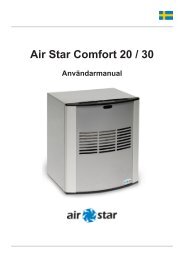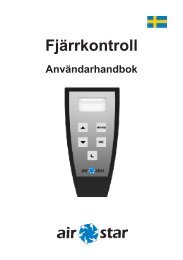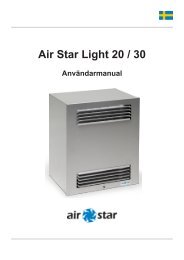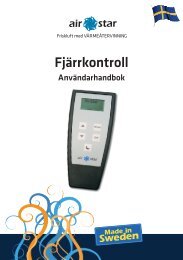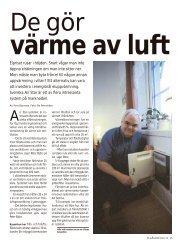Untitled - Air Star AB
Untitled - Air Star AB
Untitled - Air Star AB
Create successful ePaper yourself
Turn your PDF publications into a flip-book with our unique Google optimized e-Paper software.
Better savings on energy with <strong>Air</strong> <strong>Star</strong>!<br />
<strong>Air</strong> <strong>Star</strong> ventilation recovers on average 85 % of the heat energy in exhaust air. In a residence of 125 m 2<br />
you can reduce your energy consumption by over 6,000 kwh/year* by installing <strong>Air</strong> <strong>Star</strong>!<br />
As part of the natural ventilation process, the air is sucked from the<br />
house by the thermal force that is created when warm air meets<br />
cold air. The warm air, which is lighter in weight, rises and is transported<br />
through the exhaust piping. The efficiency of the system<br />
is affected by differences in temperature between the indoor and<br />
outdoor air. This leads to better efficiency during winter time,<br />
when the outdoor temperature is low. In older residences it is<br />
common to have the ventilation exhaust pipe mounted around<br />
the smoke pipe. The smoke pipe works as an engine and heats the<br />
exhaust air, which results in a more efficient natural ventilation<br />
system. Nowadays it is common to change from a wood stove to<br />
a more modern solution for residential heating, such as a district<br />
heating network. This renewal creates another problem. The natural<br />
ventilation is highly reduced, as the smoke pipe is not in use.<br />
Exhust air<br />
This diagram shows two Swedish cities, Malmö and Kiruna.<br />
In Kiruna, in northern Sweden the savings reach about<br />
7,750 kwh per year and in Malmö 4,874 kwh per year compared<br />
to natural ventilation. If you have mechanical ventilation<br />
you will save even more, while the savings will not be as<br />
much if there is ventilation with a central heat exchanger unit<br />
with ducts.<br />
<strong>Air</strong> <strong>Star</strong>, however, will always be a good financial solution<br />
when it comes to ventilation.<br />
Supply air<br />
Mechanical exhaust ventilation<br />
Indoor temperature<br />
20 0 C<br />
Supply air<br />
Energy consumption for ventilation<br />
Natural ventilation (S)<br />
Indoor temperature<br />
20 0 C<br />
This is S-ventilation, the most common type in houses in Sweden today.<br />
S-ventilation: 125 x 53 kwh/year = 6,625 kwh/year<br />
<strong>Air</strong> <strong>Star</strong>: 125 x 9 kwh/year = 1,125 kwh/year<br />
Savings with <strong>Air</strong> <strong>Star</strong>: 5 5000 kwh/year*<br />
The dashed line in the diagram indicates that energy consumption from<br />
ventilation in smaller residences of 125 m 2 around Stockholm is as follows:<br />
The calculation assumes a fully functional ventilation system according<br />
to the Swedish standard set by Boverket, The Swedish National Board of<br />
Housing, Building and Planning.<br />
110<br />
kWh/year, m 2<br />
100<br />
90<br />
F-ventilation<br />
80<br />
70<br />
60<br />
50<br />
40<br />
30<br />
20<br />
10<br />
0<br />
S-ventilation<br />
AIR STAR<br />
-2 -1 0 1 2 3 4 5 6 7 8 9 10<br />
Yearly mean temperature<br />
Exhaust ventilation (F)<br />
This is F-ventilation, where a fan extracts the exhaust air.<br />
F-ventilation: 125 x 67 kwh/year = 8,375 kwh/year<br />
<strong>Air</strong> <strong>Star</strong>: 125 x 9 kwh/year = 1,125 kwh/year<br />
Savings with <strong>Air</strong> <strong>Star</strong>: 7,250 kwh/year*<br />
* The calculation assumes that both comparing objects have fully functional ventilation<br />
according to the Swedish standard set by Boverket, The Swedish National Board<br />
of Housing, Building and Planning<br />
Yearly mean temperature:<br />
Stockholm +6,6 • Edinburgh +8,5 •<br />
Moscow +5,0 • Groningen +8,6 •<br />
Berlin +8,9 • Maastricht +13,3 •<br />
Vienna +9,9 • Paris +10,6 •<br />
London +9,6 • Madrid +14,3 •<br />
1<br />
LA10 correspond to a sound absorber in bedroom<br />
2<br />
LA20 correspond to a sound absorber in a living room<br />
The heat exchanger recovers,<br />
on average, 85 % of the heat<br />
from the exhaust air.<br />
TECHNICAL FACTS<br />
Product: COMFORT 20 COMFORT 30<br />
<strong>Air</strong> flow: 4,44- 8,89 l/s 5,56-13,33 l/s<br />
16-32 m 3 /h 20-48 m 3 /h<br />
Energy efficiency: on average, 85 %<br />
Rated power: 830 W<br />
Mains connection: 230-240V<br />
Fans<br />
(run alternately): 10-30 W<br />
Heating element: 0-800 W, runs only during supply air phase when necessary<br />
Noise level:<br />
Comfort 20: LA 10 1 : 29-40 dB (A) • LA 20 2 : 26-37 dB (A)<br />
Comfort 30: LA 10 1 :<br />
32-43 dB (A) • LA 20 2 : 29-40 dB (A)<br />
Unit casing: 1 mm aluminium-zinc<br />
Cassette: W: 290 H: 340 D: 204 mm (exterior dimensions)<br />
Door:<br />
15-50 mm<br />
Wall bushing: 100 mm diameter<br />
Warranty: 5 years for private use, 2 years for businesses/professional users<br />
Quality assurance: <strong>Air</strong> <strong>Star</strong> is S-marked (approved by the Swedish electrical<br />
authorities), CE-marked and European Patented<br />
For technical data on other products, visit our website: www.airstar.se.




